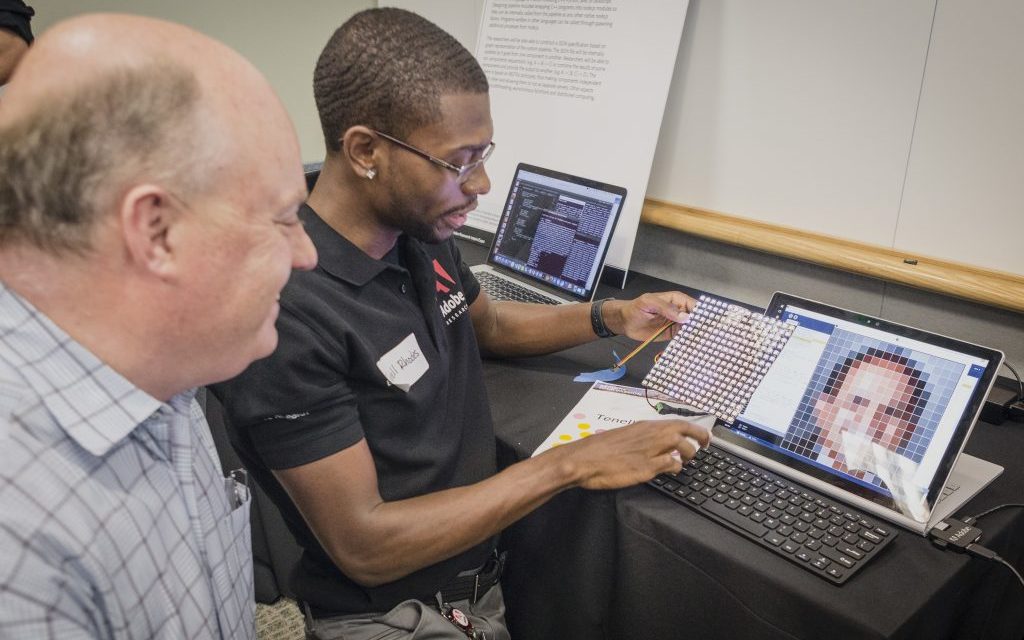By Aaron McClendon
Moguldon.com, February 13, 2018 —

Aaron McClendon
Aaron McClendon is an analyst at Detroit Venture Partners, which backs seed and early-stage startup teams. New to the VC game, Aaron searched for — and couldn’t find — a comprehensive network of black men at VC firms, so he made his own. As a fellow of Venture for America, he’s getting startup training in an emerging U.S. city, living and working for two years at one its partner companies. The fellowship is for recent grads who want to learn how to build a business while making an impact. Aaron studied at Western Michigan University Haworth College of Business.
The National GEM Consortium (Graduate Education for Minorities) is a network of leading corporations, government laboratories, top universities, and top research institutions that enables qualified students from underrepresented communities to pursue graduate education in applied science and engineering.
There are graduate fellowship programs for underrepresented MBA candidates, but not so much for grad students pursuing advanced degrees in STEM. It’s unfortunate that programs like GEM fly under the radar. I’d like to help GEM build brand awareness and reach some of the big tech firms that struggle to hire diverse technical candidates.” — Aaron McClendon
People questioned why I decided to pursue a fellowship program after finishing college.
I did it for the same reasons anyone would join a fraternity or sorority:
- To have a network of talented, like-minded individuals throughout the country that I can call on for support and build relationships with.
- To gain exposure to projects and career opportunities that I otherwise wouldn’t have access to.
- To leverage an abundance of funding, resources, advisors, and collaborators, should I decide to explore my own creative projects.
And like Steve Jobs said, A-players like to work with other A-players.
Joining a top fellowship program was one the fastest ways to surround myself with other A-players.
The benefits of a fellowship network can be critical early in your career because it allows you to take more risks, which shapes the possibilities of where you can take it.
But one difference between fellowships and fraternities is you get paid to be in a fellowship.

Courtesy Aaron McClendon
So whenever I get into a discussion about higher education, I first think about what makes sense to study, what kind of people I’d want to be surrounded by, and how I could ever afford it.
The mass adoption of artificial intelligence is inevitable. Soon, most monotonous work will be replaced by machine learning algorithms.
Instead of fighting the inevitable, I enjoy learning about AI and meeting founders building AI-driven companies.

TJ Rhodes, a 2015 GEM Fellow. Photo provided by Aaron McClendon
It’s better to be invested in disruptive technologies than to be reactive towards them. So if I took a STEM path, I’d study data science.
It’s only natural that I’d want to be surrounded by young people studying machine learning at top universities like Daniel Martin and Claudia Roberts, as well as people that share my interest of technology and design like Hope Idaewor.
These A-player graduate students are building the future. And not only are they insanely smart, but they are also minorities. As a minority myself, it’s incredibly encouraging to be surrounded by other diverse A-level talent.
So how are these three diverse students building such a powerful graduate school network without getting buried in massive student-loan debt?
The answer is a fellowship program called GEM — a graduate fellowship program for minorities pursuing higher education degrees in STEM fields (science, technology, engineering and math).
The National GEM Consortium (Graduate Education for Minorities) is a network of leading corporations, government laboratories, top universities, and top research institutions that enables qualified students from underrepresented communities to pursue graduate education in applied science and engineering.
Each year since 1976, GEM has partnered with more than 30 corporations to offer full and partial scholarships to a cohort of 150-plus diverse STEM candidates.
Once the application period is over, GEM reviews hundreds of applicants and advances the most qualified for final-round interviews with GEM’s corporate sponsors.
After final selections are made, GEM fellows complete graduate and doctoral degrees from top universities, and then go on to become leaders at the world’s leading corporations like Amazon and Intel.
Many even take the academia route, like chaired Massachusetts Institute of Technology professor and GEM alumna Dr. Christine Ortiz, and Yale’s first black tenured engineering professor, Dr. Andre D. Taylor.
Not only do GEM Fellows get their tuition funded, but they’re basically guaranteed competitive STEM internships with partner companies while completing their studies.
GEM sponsors get a first look at the nation’s top diverse tech talent before they go on to become like their predecessors: Fortune 500 CEOs like Ursula Burns and rocket scientist-turned-VR technology leaders like Mary Spio.

Sara Perkovic with Adobe interns. Photo provided by Aaron McClendon
One company that has already taken notice of GEM’s track record for excellence is Adobe.
Adobe began partnering with GEM in 2012 to fund Ph.D. students.
“Within two years, the program was expanded to all Adobe, and the focus shifted to support both master’s and Ph.D. students,” says Sara Perkovic, Adobe’s director of research programs.
Adobe is already enjoying the benefits of sponsoring GEM Fellows like 2015 Fellow TJ Rhodes.
Since joining Adobe’s research organization, TJ has already established a new hardware prototyping initiativeas their first hardware research engineer.
For major companies that have struggled to hire diverse technical talent like LinkedIn and Google, GEM is clearly both a fertile and cost-effective recruiting ground for diverse, A-level rising stars.










